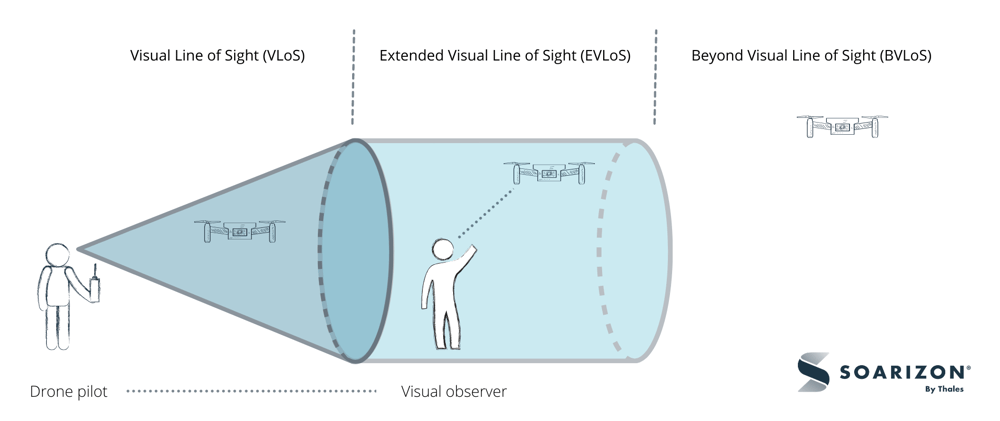The terms Visual Line of Sight (VLOS), Extended Visual Line of Sight (EVLOS) and Beyond Visual Line of Sight (BVLOS) are used regularly by the drone industry, but what do they mean? And why do you need to know these terms when considering a drone programme?
It’s critical to know what these terms mean so that you can mitigate the risks to the business or organisation, by anticipating and addressing the correct procedures for each type of flight operation.
What is VLOS (Visual Line of Sight)?
One of the most globally misunderstood rules in drone operations is the requirements to operate an Unmanned Aircraft (also known as Unmanned Air Vehicle (UAV) or Remotely Piloted Aircraft (RPA) within VLOS.
Visual Line of Sight (‘VLOS’) operations are a type of UAS operation in which the remote pilot maintains continuous, unaided visual contact with the unmanned aircraft. In its simplest term, the aircraft must always be visible to the pilot.
This allows the remote pilot to control the flight path of the unmanned aircraft in relation to other aircraft, people, and obstacles for the purpose of avoiding collisions. The aircraft may not be flown behind trees, buildings, or other obstacles.
Unaided visual contact means natural eyesight, with prescription glasses or sunglasses; however, binoculars, telescopes etc are not a permitted method for VLOS flights.
The Regulations in the UK and Europe create an offence to operate an Unmanned Aircraft outside of permitted rules and procedures; a breach of the rule carries significant penalties.

What is EVLOS (Extended Visual Line of Sight)?
Extended Visual Line of Sight operations ('EVLOS') allows flight Beyond Visual Line of Sight of the Remote Pilot by using ‘trained observers’. Trained observers are used to comply with the separation and collision avoidance responsibilities of the operator.
Fundamentally, EVLOS is an operational method where a pilot is always present on a location with one or more external observers keeping the UAV in their line of sight.
At the same time, these observers communicate critical flight information through radio to assist the pilot in maintaining a safe distance from other air users, both manned and unmanned, as well as structures, terrain and other hazards.
EVLOS operations require special permission from your respective Aviation Authority. Permission for EVLOS operations can usually be obtained through a straightforward approval process in most countries.
EVLOS is not location-specific, unlike BVLOS, with observers who can be trained in-house or through a professional training organisation as required.
What is BVLOS (Beyond Visual Line of Sight)?
BVLOS (sometimes also called BLOS), means ‘Beyond Visual Line of Sight' operations. This is where the flying of a drone is without a pilot maintaining visual line of sight on the aircraft at all times. Instead, the pilot operates the UAV using Remote Pilot Station (RPS) / Ground Control Station (GCS) instruments.
An unmanned aircraft being operated BVLOS no longer has the protection of the pilot or observer to avoid terrain, obstacles or other aircraft (called ‘See and Avoid’ or ‘Detect and Avoid’ (DAA)). BVLOS operations require extremely careful planning by operators with a framework process in place with most Aviation Authorities, in which to justify and explain the procedures to be followed during the flight.
While operations outside of a pilot’s line of sight have been available for some time under BVLOS provisions, the pilot training requirements are generally arduous, and approvals are issued on a location-by-location, case-by-case basis.
Obtaining an approval to fly BVLOS, while hugely valuable, is a challenging task.
In May 2020, with the world in the grips of the global COVID 19 pandemic, the ScaleFlyt team worked in partnership with drone deliveries provider Skyports, on a ground-breaking, first of a kind, BVLOS medical drone delivery trial. You can read more about this here.
How does ScaleFlyt help?
ScaleFlyt supports clear articulation of the operating safety case for VLOS, EVLOS and BVLOS operations and can be used to prove compliance to aviation authorities.
Pilots and organisation must always comply with the legal requirements of the nation and their permitted mission envelope; once approved, ScaleFlyt maintains a central point of truth for all operations, including features to enable: